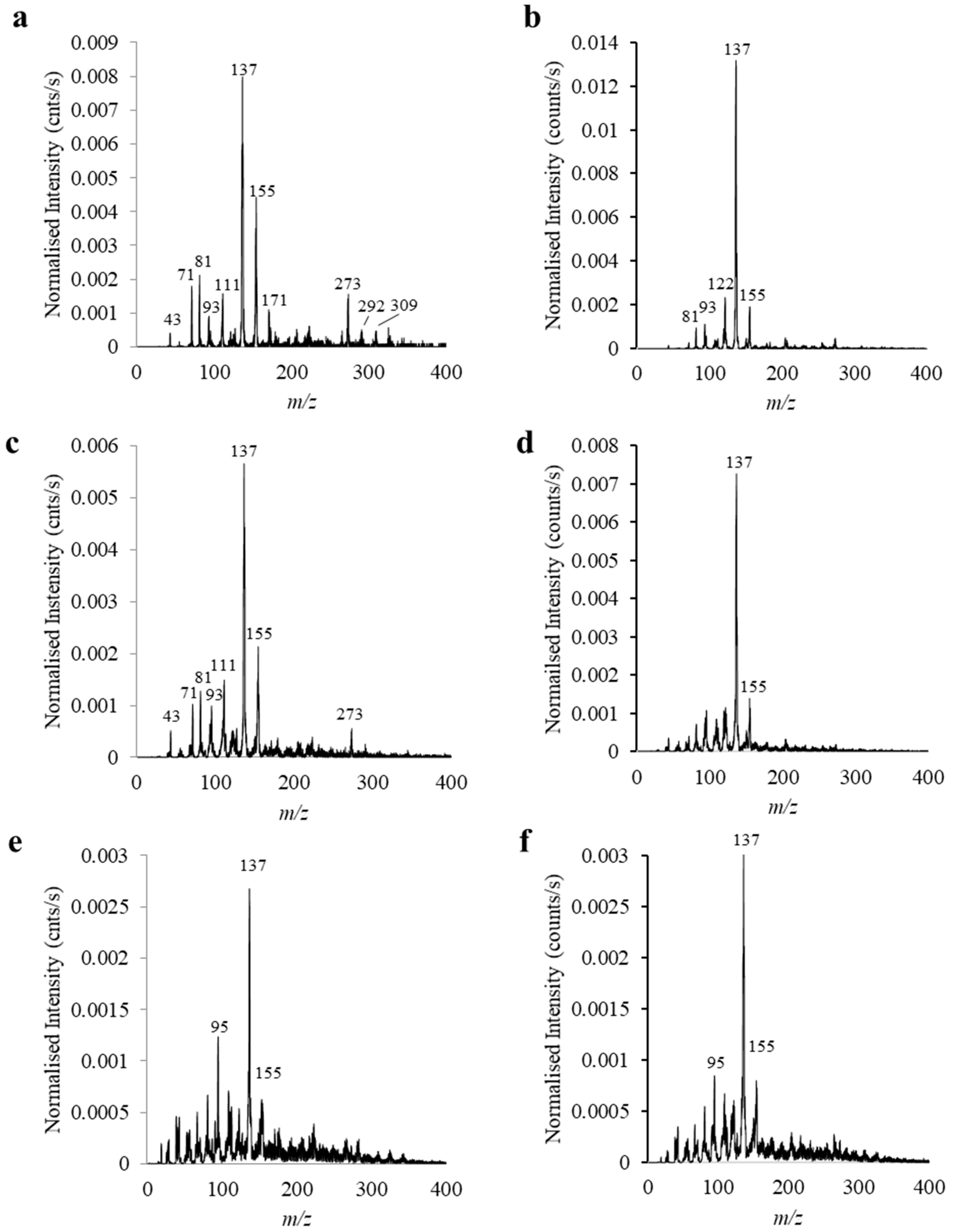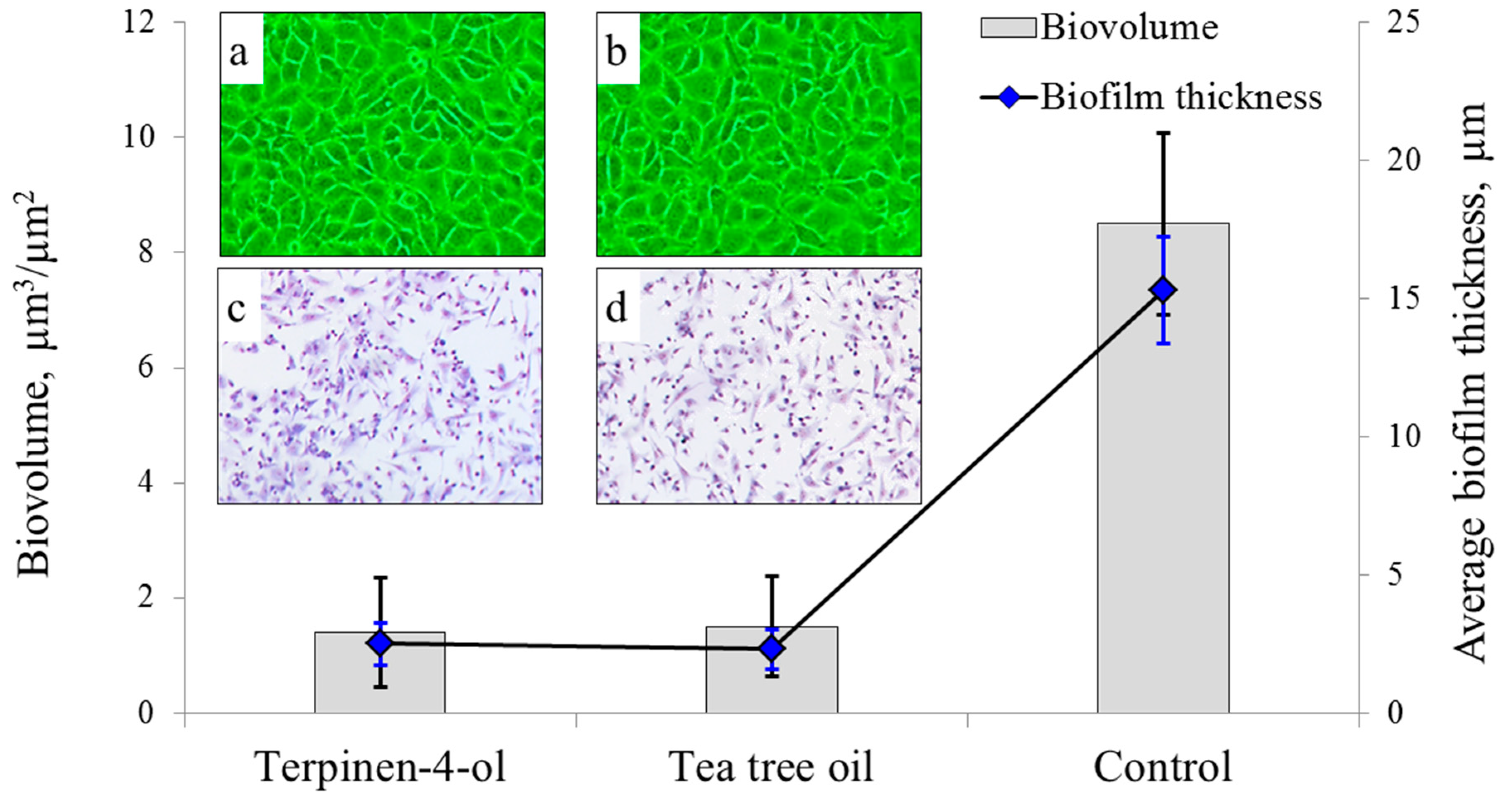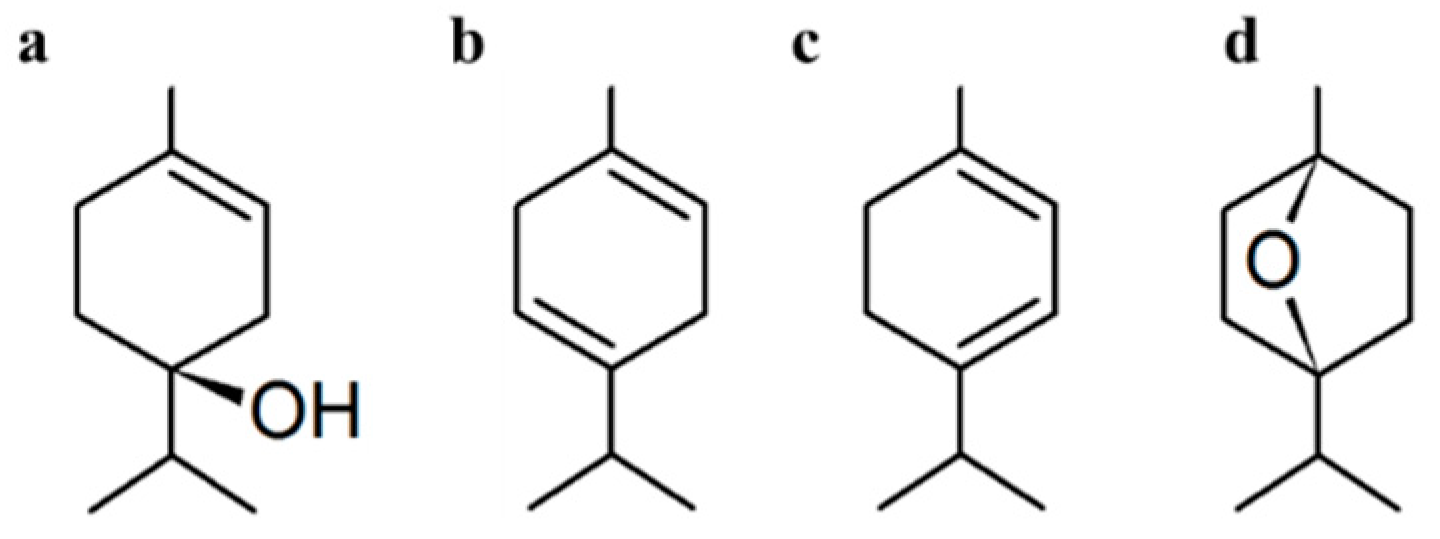Comparative Study of Natural Terpenoid Precursors in Reactive Plasmas for Thin Film Deposition
Abstract
1. Introduction
2. Results and Discussion
2.1. Plasma Characteristics—Commonly Reported Parameters
2.2. Ion Energy Distribution Functions
2.3. Plasma Characteristics—Residual Gas Analysis of Terpinen-4-ol
2.4. Plasma Characteristics—Positive Ion Mode Analysis of Terpinen-4-ol and M. alternifolia Oil
2.5. Biological Assay
3. Materials and Methods
4. Conclusions
Author Contributions
Funding
Institutional Review Board Statement
Informed Consent Statement
Data Availability Statement
Conflicts of Interest
References
- Ooi, P.C.; Razip Wee, M.F.M.; Hussain, A.H. Fabrication of Highly Stable Non-Volatile Memory Device Using Plasma-Polymerisation of Hexamethyldisiloxane with Graphene Quantum Dots. J. Phys. Conf. Ser. 2020, 1535, 012013. [Google Scholar] [CrossRef]
- Rout, B.; Girard-Lauriault, P.-L. Permeation-resistant and flexible plasma-polymerised films on 2-hydroxyethyl methacrylate hydrogels. Plasma Process. Polym. 2021, 18, 2000191. [Google Scholar] [CrossRef]
- Ibrahim, J.; Al-Bataineh, S.A.; Michelmore, A.; Whittle, J.D. Atmospheric Pressure Dielectric Barrier Discharges for the Deposition of Organic Plasma Polymer Coatings for Biomedical Application. Plasma Chem. Plasma Process. 2021, 41, 47–83. [Google Scholar] [CrossRef]
- Kliewer, S.; Wicha, S.G.; Bröker, A.; Naundorf, T.; Catmadim, T.; Oellingrath, E.K.; Rohnke, M.; Streit, W.R.; Vollstedt, C.; Kipphardt, H.; et al. Contact-active antibacterial polyethylene foils via atmospheric air plasma induced polymerisation of quaternary ammonium salts. Colloids Surf. B Biointerfaces 2020, 186, 110679. [Google Scholar] [CrossRef]
- Levchenko, I.; Bazaka, K.; Belmonte, T.; Keidar, M.; Xu, S. Advanced Materials for Next-Generation Spacecraft. Adv. Mater. 2018, 30, 1802201. [Google Scholar] [CrossRef] [PubMed]
- Ahmad, J.; Bazaka, K.; Anderson, L.J.; White, R.D.; Jacob, M.V. Materials and methods for encapsulation of OPV: A review. Renew. Sustain. Energy Rev. 2013, 27, 104–117. [Google Scholar] [CrossRef]
- Levchenko, I.; Bazaka, K.; Keidar, M.; Xu, S.; Fang, J. Hierarchical Multicomponent Inorganic Metamaterials: Intrinsically Driven Self-Assembly at the Nanoscale. Adv. Mater. 2018, 30, 1702226. [Google Scholar] [CrossRef]
- Toren, P.; Smolka, M.; Haase, A.; Palfinger, U.; Nees, D.; Ruttloff, S.; Kuna, L.; Schaude, C.; Jauk, S.; Rumpler, M.; et al. High-throughput roll-to-roll production of polymer biochips for multiplexed DNA detection in point-of-care diagnostics. Lab A Chip 2020, 20, 4106–4117. [Google Scholar] [CrossRef]
- Asadian, M.; Chan, K.V.; Egghe, T.; Onyshchenko, Y.; Grande, S.; Declercq, H.; Cools, P.; Morent, R.; De Geyter, N. Acrylic acid plasma polymerization and post-plasma ethylene diamine grafting for enhanced bone marrow mesenchymal stem cell behaviour on polycaprolactone nanofibers. Appl. Surf. Sci. 2021, 563, 150363. [Google Scholar] [CrossRef]
- Griesser, S.S.; Jasieniak, M.; Vasilev, K.; Griesser, H.J. Antimicrobial Peptides Grafted onto a Plasma Polymer Interlayer Platform: Performance upon Extended Bacterial Challenge. Coatings 2021, 11, 68. [Google Scholar] [CrossRef]
- Jang, H.J.; Jung, E.Y.; Parsons, T.; Tae, H.-S.; Park, C.-S. A Review of Plasma Synthesis Methods for Polymer Films and Nanoparticles under Atmospheric Pressure Conditions. Polymers 2021, 13, 2267. [Google Scholar] [CrossRef]
- Jalaber, V.; Del Frari, D.; De Winter, J.; Mehennaoui, K.; Planchon, S.; Choquet, P.; Detrembleur, C.; Moreno-Couranjou, M. Atmospheric Aerosol Assisted Pulsed Plasma Polymerization: An Environmentally Friendly Technique for Tunable Catechol-Bearing Thin Films. Front. Chem. 2019, 7, 183–183. [Google Scholar] [CrossRef] [PubMed]
- Friedrich, J. Mechanisms of Plasma Polymerization—Reviewed from a Chemical Point of View. Plasma Process. Polym. 2011, 8, 20. [Google Scholar] [CrossRef]
- Carletto, A.; Badyal, J.P.S. Ultra-high selectivity pulsed plasmachemical deposition reaction pathways. Phys. Chem. Chem. Phys. 2019, 21, 16468–16476. [Google Scholar] [CrossRef] [PubMed]
- Bazaka, O.; Bazaka, K.; Truong, V.K.; Levchenko, I.; Jacob, M.V.; Estrin, Y.; Lapovok, R.; Chichkov, B.; Fadeeva, E.; Kingshott, P.; et al. Effect of titanium surface topography on plasma deposition of antibacterial polymer coatings. Appl. Surf. Sci. 2020, 521, 146375. [Google Scholar] [CrossRef]
- Baranov, O.; Levchenko, I.; Bell, J.M.; Lim, J.W.M.; Huang, S.; Xu, L.; Wang, B.; Aussems, D.U.B.; Xu, S.; Bazaka, K. From nanometre to millimetre: A range of capabilities for plasma-enabled surface functionalization and nanostructuring. Mater. Horiz. 2018, 5, 765–798. [Google Scholar] [CrossRef]
- Jacob, M.V.; Taguchi, D.; Iwamoto, M.; Bazaka, K.; Rawat, R.S. Resistive switching in graphene-organic device: Charge transport properties of graphene-organic device through electric field induced optical second harmonic generation and charge modulation spectroscopy. Carbon 2017, 112, 111–116. [Google Scholar] [CrossRef]
- Baranov, O.; Bazaka, K.; Kersten, H.; Keidar, M.; Cvelbar, U.; Xu, S.; Levchenko, I. Plasma under control: Advanced solutions and perspectives for plasma flux management in material treatment and nanosynthesis. Appl. Phys. Rev. 2017, 4, 041302. [Google Scholar] [CrossRef]
- Baranov, O.; Xu, S.; Ostrikov, K.; Wang, B.B.; Cvelbar, U.; Bazaka, K.; Levchenko, I. Towards universal plasma-enabled platform for the advanced nanofabrication: Plasma physics level approach. Rev. Mod. Plasma Phys. 2018, 2, 4. [Google Scholar] [CrossRef]
- Bazaka, K.; Jacob, M.V.; Ostrikov, K. Sustainable Life Cycles of Natural-Precursor-Derived Nanocarbons. Chem. Rev. 2016, 116, 52. [Google Scholar] [CrossRef]
- Jacob, M.V.; Rawat, R.S.; Ouyang, B.; Bazaka, K.; Kumar, D.S.; Taguchi, D.; Iwamoto, M.; Neupane, R.; Varghese, O.K. Catalyst-Free Plasma Enhanced Growth of Graphene from Sustainable Sources. Nano Lett. 2015, 15, 5702–5708. [Google Scholar] [CrossRef] [PubMed]
- Al-Jumaili, A.; Mulvey, P.; Kumar, A.; Prasad, K.; Bazaka, K.; Warner, J.; Jacob, M.V. Eco-friendly nanocomposites derived from geranium oil and zinc oxide in one step approach. Sci. Rep. 2019, 9, 5973. [Google Scholar] [CrossRef] [PubMed]
- Al-Jumaili, A.; Bazaka, K.; Jacob, M.V. Retention of Antibacterial Activity in Geranium Plasma Polymer Thin Films. Nanomaterials 2017, 7, 270. [Google Scholar] [CrossRef] [PubMed]
- Bazaka, K.; Jacob, M.V.; Bowden, B.F. Optical and chemical properties of polyterpenol thin films deposited via plasma-enhanced chemical vapor deposition. J. Mater. Res. 2011, 26, 1018–1025. [Google Scholar] [CrossRef]
- Jacob, M.V.; Bazaka, K.; Weis, M.; Taguchi, D.; Manaka, T.; Iwamoto, M. Fabrication and characterization of polyterpenol as an insulating layer and incorporated organic field effect transistor. Thin Solid Film. 2010, 518, 6123–6129. [Google Scholar] [CrossRef]
- Bazaka, K.; Jacob, M.V. Nanotribological and nanomechanical properties of plasma-polymerized polyterpenol thin films. J. Mater. Res. 2011, 26, 2952–2961. [Google Scholar] [CrossRef]
- Bazaka, K.; Jacob, M.V.; Truong, V.K.; Crawford, R.J.; Ivanova, E.P. The Effect of Polyterpenol Thin Film Surfaces on Bacterial Viability and Adhesion. Polymers 2011, 3, 388–404. [Google Scholar] [CrossRef]
- Kumar, A.; Mills, S.; Bazaka, K.; Bajema, N.; Atkinson, I.; Jacob, M.V. Biodegradable optically transparent terpinen-4-ol thin films for marine antifouling applications. Surf. Coat. Technol. 2018, 349, 426–433. [Google Scholar] [CrossRef]
- Bazaka, K.; Jacob, M.V. Post-deposition ageing reactions of plasma derived polyterpenol thin films. Polym. Degrad. Stab. 2010, 95, 1123–1128. [Google Scholar] [CrossRef]
- Bazaka, K.; Bazaka, O.; Levchenko, I.; Xu, S.; Ivanova, E.P.; Keidar, M.; Ostrikov, K. Plasma-potentiated small molecules—possible alternative to antibiotics? Nano Futures 2017, 1, 025002. [Google Scholar] [CrossRef]
- Jacob, M.V.; Bazaka, K.; Taguchi, D.; Manaka, T.; Iwamoto, M. Electron-blocking hole-transport polyterpenol thin films. Chem. Phys. Lett. 2012, 528, 26–28. [Google Scholar] [CrossRef]
- Bazaka, K.; Jacob, M.V.; Taguchi, D.; Manaka, T.; Iwamoto, M. Investigation of interfacial charging and discharging in double-layer pentacene-based metal-insulator-metal device with polyterpenol blocking layer using electric field induced second harmonic generation. Chem. Phys. Lett. 2011, 503, 105–111. [Google Scholar] [CrossRef]
- Haddow, D.B.; France, R.M.; Short, R.D.; Bradley, J.W.; Barton, D. A Mass Spectrometric and Ion Energy Study of the Continuous Wave Plasma Polymerization of Acrylic Acid. Langmuir 2000, 16, 7. [Google Scholar] [CrossRef]
- Zhang, Z.; Knoll, W.; Forch, R. Amino-functionalized plasma polymer films for DNA immobilization and hybridization. Surf. Coat. Technol. 2005, 200, 3. [Google Scholar] [CrossRef]
- Hazrati, H.D.; Whittle, J.D.; Vasilev, K. A Mechanistic Study of the Plasma Polymerization of Ethanol. Plasma Process. Polym. 2014, 11, 9. [Google Scholar] [CrossRef]
- Pizzini, S. Advanced Silicon Materials for Photovoltaic Applications; John Wiley and Sons: Hoboken, NJ, USA, 2012. [Google Scholar]
- Yasuda, H.K. Plasma Polymerization; Academic Press: London, UK, 1985. [Google Scholar]
- Whittle, J.D.; Short, R.D.; Steele, D.A.; Bradley, J.W.; Bryant, P.M.; Jan, F.; Biederman, H.; Serov, A.A.; Choukurov, A.; Hook, A.L.; et al. Variability in Plasma Polymerization Processes—An International Round-Robin Study. Plasma Process. Polym. 2013, 10, 12. [Google Scholar] [CrossRef]
- Ahmad, J.; Bazaka, K.; Whittle, J.D.; Michelmore, A.; Jacob, M.V. Structural Characterization of γ-Terpinene Thin Films Using Mass Spectroscopy and X-Ray Photoelectron Spectroscopy. Plasma Process. Polym. 2015, 12, 10. [Google Scholar] [CrossRef]
- Jacob, M.V.; Olsen, N.S.; Anderson, L.J.; Bazaka, K.; Shanks, R.A. Plasma polymerised thin films for flexible electronic applications. Thin Solid Film. 2013, 546, 167–170. [Google Scholar] [CrossRef]
- Shi, F.F. Recent advances in polymer thin films prepared by plasma polymerization: Synthesis, structural characterization, properties and applications. Surf. Coat. Technol. 1996, 82, 15. [Google Scholar] [CrossRef]
- Jacobs, D.C. Reactive Collisions of Hyperthermal Energy Molecular Ions with Solid Surfaces. Annu. Rev. Phys. Chem. 2002, 53, 30. [Google Scholar] [CrossRef] [PubMed]
- Stafford, L.; Margot, J.; Chaker, M.; Pearton, S.J. Energy dependence of ion-assisted chemical etch rates in reactive plasmas. Appl. Phys. Lett. 2005, 87, 3. [Google Scholar] [CrossRef]
- Czeremuszkin, G.; Wrobel, A.M.; Kryszewski, M. Plasma polymerization of organoisothiocyanates. I. Characterization of deposition process and deposited materials. J. Appl. Polym. Sci. 1992, 44, 7. [Google Scholar] [CrossRef]
- Meichsner, J.; Zeuner, M.; Krames, B.; Nitschke, M.; Rochotzki, R.; Barucki, K. Plasma diagnostics for surface modification of polymers. Surf. Coat. Technol. 1998, 98, 7. [Google Scholar] [CrossRef]
- Schwarzenbach, W.; Howling, A.A.; Fivaz, M.; Brunner, S.; Hollenstein, C. Sheath impedance effects in very high frequency plasma experiments. J. Vac. Sci. Technol. 1996, 14, 7. [Google Scholar] [CrossRef][Green Version]
- Zeuner, M.; Neumann, H.; Meichsner, J. Ion energy distributions in a dc biased rf discharge. J. Appl. Phys. 1997, 81, 10. [Google Scholar] [CrossRef]
- Sobolewski, M.A.; Olthoff, J.K.; Wang, Y. Ion energy distributions and sheath voltages in a radio-frequency-bioased, inductively coupled, high-density plasma reactor. J. Appl. Phys. 1999, 85. [Google Scholar] [CrossRef]
- Kersten, H.; Deutsch, H.; Steffen, H.; Kroesen, G.M.W.; Hippler, R. The energy balance at substrate surfaces during plasma processing. Vacuum 2001, 63, 47. [Google Scholar] [CrossRef]
- Buzzi, F.L.; Ting, Y.-H.; Wendt, A.E. Energy distribution of bombarding ions in plasma etching of dielectrics. Plasma Sources Sci. Technol. 2009, 18, 8. [Google Scholar] [CrossRef]
- Kadlec, S.; Quaeyhaegens, C.; Knuyt, G.; Stals, L.M. Energy distribution of ions in an unbalanced magnetron plasma measured with energy-resolved mass spectrometry. Surf. Coat. Technol. 1997, 89, 8. [Google Scholar] [CrossRef]
- Bazaka, K.; Jacob, M.V.; Truong, V.K.; Wang, F.; Pushpamali, W.A.A.; Wang, J.Y.; Ellis, A.V.; Berndt, C.C.; Crawford, R.J.; Ivanova, E.P. Plasma-Enhanced Synthesis of Bioactive Polymeric Coatings from Monoterpene Alcohols: A Combined Experimental and Theoretical Study. Biomacromolecules 2010, 11, 11. [Google Scholar] [CrossRef]
- Carson, C.F.; Hammer, K.A.; Riley, T.V. Melaleuca alternifolia (Tea Tree) Oil: A Review of Antimicrobial and Other Medicinal Properties. Clin. Microbiol. Rev. 2006, 19, 13. [Google Scholar] [CrossRef]
- Brophy, J.J.; Davies, N.W.; Southwell, I.A.; Stiff, I.A.; Williams, L.R. Gas chromatographic quality control for oil of Melaleuca terpinen-4-ol type (Australian tea tree). J. Agric. Food Chem. 1989, 37, 6. [Google Scholar] [CrossRef]
- Michelmore, A.; Whittle, J.D.; Short, R.D.; Boswell, R.W.; Charles, C. An Experimental and Analytical Study of an Asymmetric Capacitively Coupled Plasma Used for Plasma Polymerization. Plasma Process. Polym. 2014, 11, 9. [Google Scholar] [CrossRef]
- Benedikt, J.; Hecimovic, A.; Ellerweg, D.; Keudell, A.V. Quadrupole mass spectrometry of reactive plasmas. J. Phys. D: Appl. Phys. 2012, 45, 24. [Google Scholar] [CrossRef]





| Nominal Generator Power [W] | Actual Transmitted Power [W] | Flow Rate, Φ [sccm] | Pressure *, P [mbar] | P/Φ | Mass Deposition Rate [µg·m−2·s−1] |
|---|---|---|---|---|---|
| 5 | 4.8 | 1.0 | 2.53 × 10−2 | 4.8 | 5.6 |
| 25 | 19.2 | 0.7 | 3.10 × 10−2 | 27.4 | 55.2 |
| 50 | 35.1 | 0.9 | 3.97 × 10−2 | 39.0 | 42.3 |
| Peak (m/z) | Assignment |
|---|---|
| 2 | H2 ·+ |
| 17 | OH +, CH4 + |
| 18 | H2O ·+ |
| 28 | CO ·+ or C2H4 ·+ |
| 43 | C3H7 + |
| 55 | C4H7 + or C3H3O + |
| 71 | C5H11 + or C4H7O + |
| 93 | C7H9 + |
| 111 | C8H15 + |
| 136 | C10H16 ·+ |
| 154 | C10H18O ·+ |
| Component | Chemical Formula | Molecular Weight | Composition (%) 1 |
|---|---|---|---|
| Terpinen-4-ol | C10H18O | 154.25 | 40.1 |
| γ-Terpinene | C10H16 | 136.24 | 23.0 |
| α-Terpinene | C10H16 | 136.24 | 10.4 |
| 1,8-Cineole | C10H18O | 154.25 | 5.1 |
| Terpinolene | C10H16 | 136.24 | 3.1 |
| ρ-Cymene | C10H14 | 134.21 | 2.9 |
| α-Pinene | C10H16 | 136.24 | 2.6 |
| α-Terpineol | C10H18O | 154.25 | 2.4 |
| Dominant Peaks | Possible Species |
|---|---|
| 309 | [2M + H] + |
| 292 | [2M − OH + H] + |
| 282 | [2M − C2H2] + |
| 273 | [2M − 2H2O + H] + |
| 267 | [M + C8H15] + |
| 223 | [M + H + C5H8] + |
| 171 | [M + OH] + |
| 155 | [M + H] + |
| 137 | [M − OH] + |
| 122 | [M − CH3 − OH] + |
| 111 | C8H15 + |
| 109 | C8H13 + |
| 93 | C7H9 + |
| 81 | [M − C4H7 − H2O] + |
| 71 | C5H11+ or C4H7O + |
| 68 | C5H8 + |
| 55 | C4H7+ or C3H3O + |
| 43 | C3H7 + |
| 30 | C2H6 + |
| 18 | H2O ·+ |
Publisher’s Note: MDPI stays neutral with regard to jurisdictional claims in published maps and institutional affiliations. |
© 2021 by the authors. Licensee MDPI, Basel, Switzerland. This article is an open access article distributed under the terms and conditions of the Creative Commons Attribution (CC BY) license (https://creativecommons.org/licenses/by/4.0/).
Share and Cite
Grant, D.S.; Ahmed, J.; Whittle, J.D.; Michelmore, A.; Vasilev, K.; Bazaka, K.; Jacob, M.V. Comparative Study of Natural Terpenoid Precursors in Reactive Plasmas for Thin Film Deposition. Molecules 2021, 26, 4762. https://doi.org/10.3390/molecules26164762
Grant DS, Ahmed J, Whittle JD, Michelmore A, Vasilev K, Bazaka K, Jacob MV. Comparative Study of Natural Terpenoid Precursors in Reactive Plasmas for Thin Film Deposition. Molecules. 2021; 26(16):4762. https://doi.org/10.3390/molecules26164762
Chicago/Turabian StyleGrant, Daniel S., Jakaria Ahmed, Jason D. Whittle, Andrew Michelmore, Krasimir Vasilev, Kateryna Bazaka, and Mohan V. Jacob. 2021. "Comparative Study of Natural Terpenoid Precursors in Reactive Plasmas for Thin Film Deposition" Molecules 26, no. 16: 4762. https://doi.org/10.3390/molecules26164762
APA StyleGrant, D. S., Ahmed, J., Whittle, J. D., Michelmore, A., Vasilev, K., Bazaka, K., & Jacob, M. V. (2021). Comparative Study of Natural Terpenoid Precursors in Reactive Plasmas for Thin Film Deposition. Molecules, 26(16), 4762. https://doi.org/10.3390/molecules26164762







